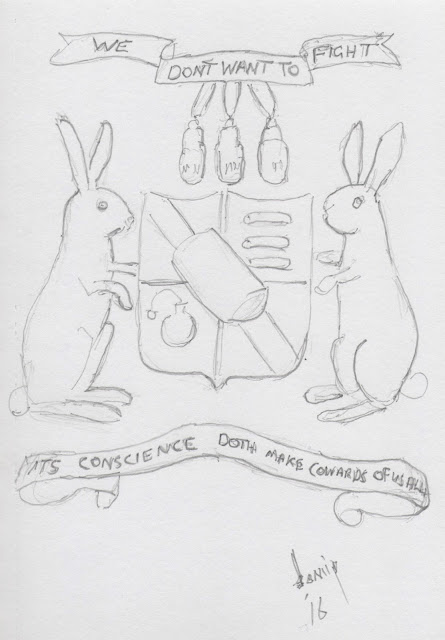Impression sketch of N.C.C.'s Coat of Arms. Published in the
Daily Mirror 20/04/1916. [online] See original image at: <https://greatwarlondon.wordpress.com/2013/03/25/the-non-combatant-corps-a-tale-of-three-objectors/> [Accessed: 20 May 2016]
The Coat of Arms
Explained:
A suggested
coat-of-arms for the Non-Combatant Corps by a Sergeant-Major then serving in
France at the time, it is blazoned (not by Heralds College); shield quartered,
three maggots recumbent proper, baby's bottle rampant, bar sinister and a down pillow. Supports two tame
rabbits rampant. Crest, three bottles of Lemonade.
i
As a rule, war
changes everything -
Foremost of all
families change
As separation
from civilian
To military men; pass from peace
Into organised
enforced discipline.
While career
soldiers might take
And accept their
lot, in time
Of alteration to
open war,
A new breed of
men volunteered
By start of war for Kitchener’s army.
With two years of
battle lines drawn,
Majority of the
old British army
Had been lost -
those left
Interspersed with
the new boys -
Pals battalions
ready for new fight.
Then there was an
issue with men
Who refused to
take up arms -
With army
conscription
For the first
time, Britain now
Faced the conscientious objector.
ii
While many formed
the Royal Army
Medical Corps, a
new battalion
Became the
Non-Combatant
Corps, formed
March 1916 - duty
Being to support with physical labour.
The NCC
No-Courage Corps; as coined
By the press - wore
uniform, to follow
Discipline rules, to undertake
All tasks, except
to take up arms
Or deal with any
type of munitions work.
3,400 became NCCs,
to baffle leaders
Of army who had
relied on principle,
'The discipline
of fear’ - men taken
From civil
occupations formed new
Challenges - the
NCCs faced difficulties.
Such conscientious objectors would
Not be the
fighting man's best pal -
How would
officers in charge
Of a non
fighting force react, with
Men refusing to
take arms and fight.
iii
17 May 1916
found Non-Combatant
Corps in France,
whose character
Came under
investigation
By reporter Philip
Gibbs; aside
Expectation of
preconceived ideas.
Landed in France
under Conscience
Clause, the NCC
Camp pitched
In La Vallee Heureuse, miles
From the
frontline - this Happy
Valley was
situated near sea coast.
The two companies
lived in tents,
Atop a hill,
close by a French
Village - along
with huts
And field canteen
- to set out
A normal image of
military camp.
Maybe, unavoidably
cast with image
Of seeing
expected weak, sickly
Appearance; 'with
the pale
Cast of thought,'
the men were
Seen as bronzed with
good physique.
iV
In khaki uniform
they held no kind
Of difference,
yet devoid of any
Arms - while one
officer
Described them as
'soft' they
Had come with
only two days training.
The tasks of the
NCCs were physical
Hard labour, with officer’s
promise
Of a few weeks to
change
All that - after
railway work, likely
To move onto 'stiffer'
undertakings.
Without
objections they answered all
Questions, in
acceptance of their
Lot - by admittance
one man
Told how the work
was hard
To shock muscles
after sedentary life.
Stating
satisfaction to their treatment,
To tell how good
the food was,
To eat as much as
they can -
They spoke of no
sense of shame
And had no qualms
to given questions.
V
Providing a
uniqueness in the army,
Many men admitted
to being
Members of Brethren
From Plymouth -
how, in their
Faith, it was
wrong to take human life.
To become
fighters would be denial
Of faith - another
young man
Said he was of Church
Of England - that
he did not
Believe in war,
or want to kill anyone.
Although seen to
be perfect for
A soldier, one youth
stood
Straight and
declared,
If they were sent
to front
To work they
would do their bit.
One of two Cambridge
men among
The company, briefly
advised
That they were not
there
Because of
cowardice; that
All there were a good set of fellows.
Vi
Whilst all were
approached with
Some expectations,
as with
The latter man
seen;
To be studious of
little hand-
Books, a user of vegetarian cafes.
Stereotype broke
on meeting one
Hefty, athletic
man to possess
A powerful face,
who declared
His religion as
Roman Catholic,
And that he was a
German stock.
In fact, he was
son of a German,
Whose four
butcher shops
In London suburbs, were
Attacked after
the sinking
Of the Lusitania,
to totally ruin him.
In brief show of
anger, his rhetoric
Was 'what had he
to fight for?'
To add he set out
to join
Army Service Corps,
surprise
Found him in
Non-Combatant Corps.
Vii
Maintaining expected
principle to see
Queer company -
mostly clerical
Types - he gave
no defence
How the 'normal' English man saw
Conscientious objectors as detestable.
How 'normal' English
men did not
Wrestle with
conscience, to kill
An enemy, in
defence of his
Country - therefore
no wonder
Soldiers saw
cowardice in refusal.
With final say
given to one officer
Of NCC, to give no
judgment;
Leaving their
conscience
To selves - he
saw behaved
Men take orders,
without complaint.
By their removed
safety from effect
Of war, evidenced
proved them
Not as martyrs,
but to admit
How the NCC had
undertaken
Hard work - no
soft job for shirkers.
by Jamie Mann.
Gibbs, P., 1916. Conscientious Objectors
- Life On Active Service. The Daily Telegraph, [online] 19 May 1916. P.10. Col.1. Available at: <http://www.telegraph.co.uk/news/ww1-archive/12210153/Daily-Telegraph-May-19-1916.html> [Accessed: 20 May 2016].
Source: File: Conscientious Objection in Britain during the First World War. Online.
Available at: <http://www.ppu.org.uk/learn/infodocs/cos/st_co_wwone1.html>
Accessed 20 May 2016
Source: File: The
Non-Combatant Corps: a tale of three objectors . Online. Available at:
<https://greatwarlondon.wordpress.com/2013/03/25/the-non-combatant-corps-a-tale-of-three-objectors/l>
Accessed 17 May 2016
Mann, J., 2016. 100 years Ago - Poems by Jamie
Mann. [letter] (Personal
communication, 20 May 2016).
#WW1 #WW1centenary #GreatWar #WW1poem #GreatWar
#WW1centenary #worldwarone #worldwaroneremembered #WW1France

No comments:
Post a Comment